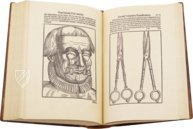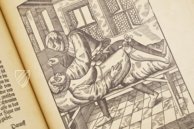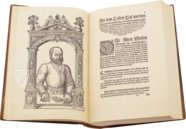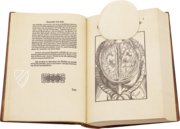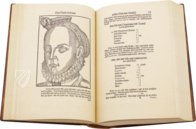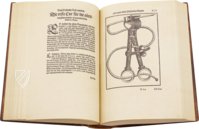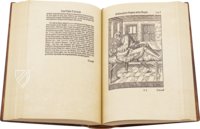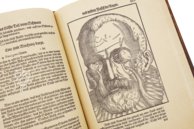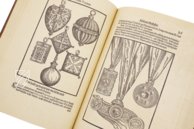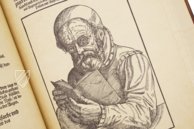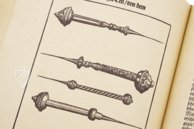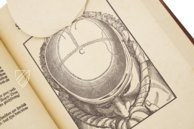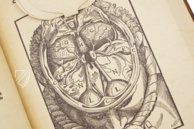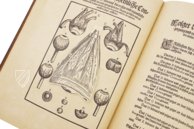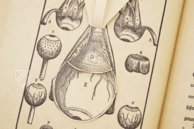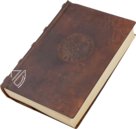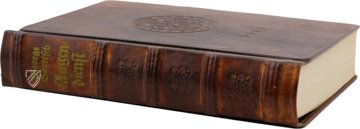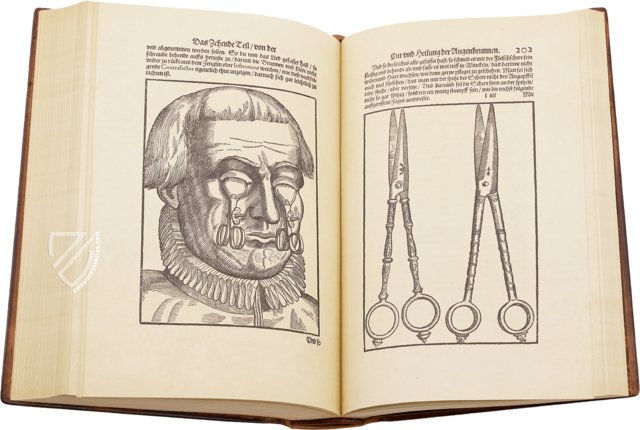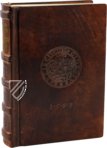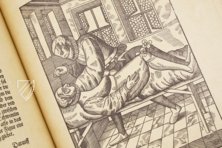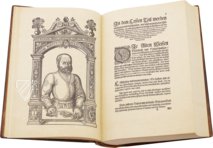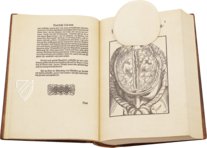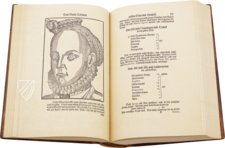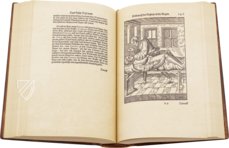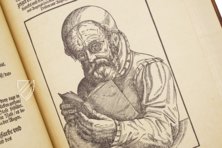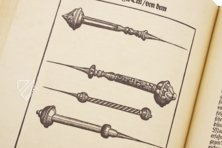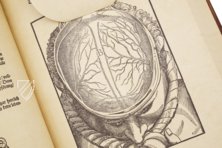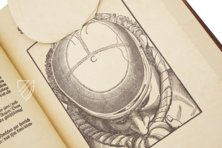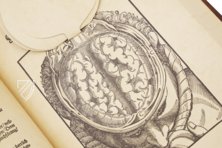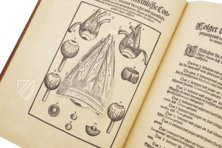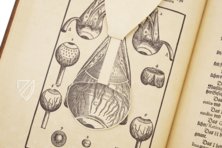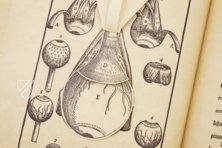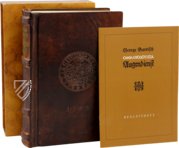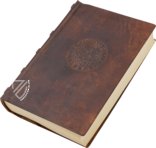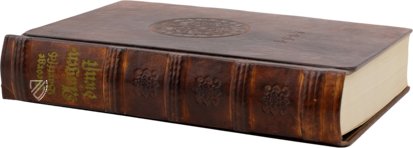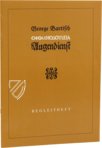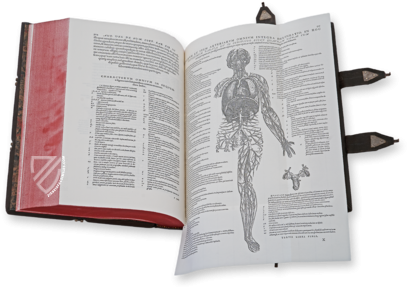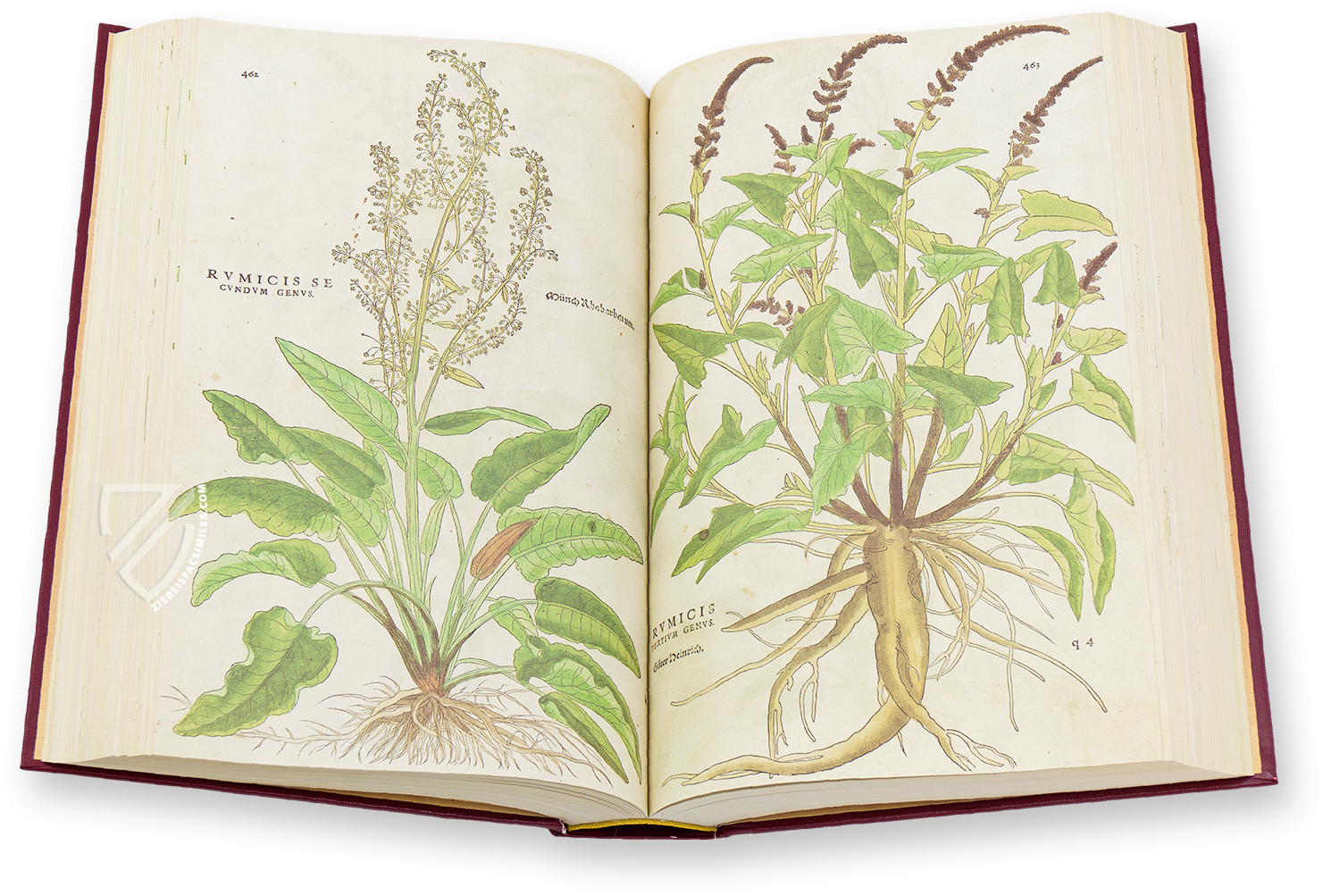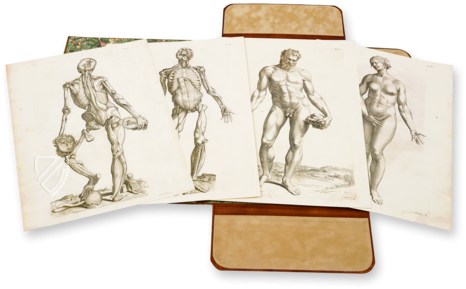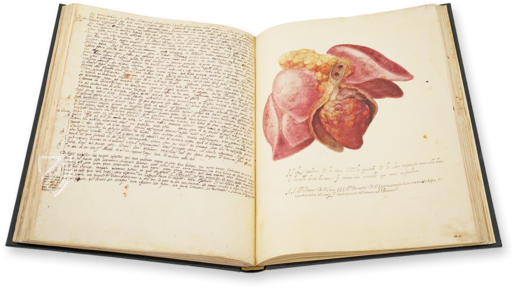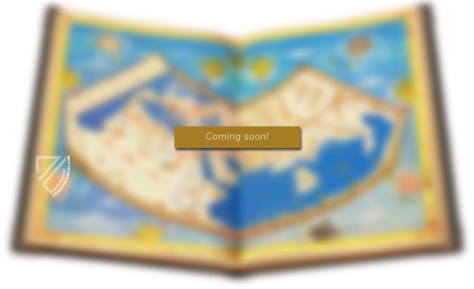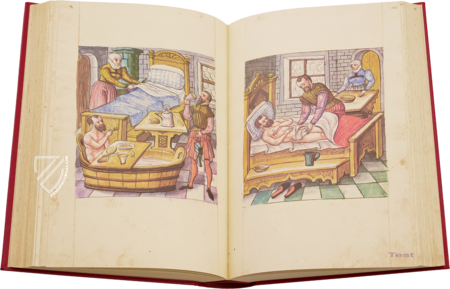Ophthalmodouleia - Augendienst
In 1583, Georg Bartisch (1535–1607) published a treatise on ophthalmology that simultaneously represents the first Renaissance work and the first comprehensive textbook in German on the subject as well as being the first work to examine it as an independent subject. He wrote the work in Dresden, printed it at his own expense and dedicated it to Elector Augustus I of Saxony (1526–1586), for whom he also served as court oculist. Although cataracts are the main subject of the work, it also contains instructions for the treatment of conjunctivitis and other eye diseases. 92 magnificent woodcuts show the anatomy and illustrate the diseases of the eye, with the instruments developed by Bartisch himself appearing throughout. Two of these woodcuts also have movable flaps showing the anatomical layers of the head and eye. They make the work a remarkable testimony to both the history of medicine and Renaissance printmaking.
Ophthalmodouleia - Augendienst
Georg Bartisch (1535-1607) was an important physician of the German Renaissance in Dresden and achieved fame above all through his ophthalmological work Ophthalmodouleia - Augendienst, which is the oldest comprehensive textbook in German on this subject. As the son of a common surgeon, he was unable to obtain an academic education - which is probably why he never learned Latin. Nevertheless, after completing his apprenticeship as a barber and surgeon, he became a well-known ophthalmologist. He not only worked as court oculist to Elector Augustus I of Saxony (1526-1586), but also developed his own instruments, which repeatedly appear in the woodcuts of the Ophthalmodouleia.
Modern Ophthalmology against Witchcraft
The main topic of the treatise dedicated to Elector Augustus is gray cataracts, which Bartisch classifies according to their color: gray, white, black, blue, green and yellow. However, he also discusses other eye diseases such as conjunctivitis and countless own recipes for ointments for all kinds of complaints. Each eye disease and the corresponding treatment are thoroughly described, including surgical practices and the instruments used. Despite the great innovation of the text and the methods described, Bartisch also adhered to traditional, superstitious ideas. For example, he advises doctors to consider the astrological conditions before every intervention and sees the causes of illness sometimes in magic and witchcraft.
92 Impressive Woodcuts
As Bartisch was initially unable to find anyone willing to publish the work, he took matters into his own hands and had the textbook printed by Matthes Stoeckel in Dresden in 1583 at his own expense. To illustrate it, he probably commissioned Hans Hewamaul (H. H.) to produce 92 remarkable woodcuts based on his own drawings, which visualize anatomical aspects as well as the treatment methods and instruments described. Particularly noteworthy are two multi-layered illustrations, on which fold-out flaps are applied, which gradually make different "levels" of the anatomy of the head and eyeball comprehensible. The woodcuts also provide an insight into the interior design and fashion of the time, as the patients' clothing in particular was depicted with great attention to detail. This makes the Ophthalmodouleia not only an outstanding testimony to modern medical history, but also a fascinating Renaissance work of art.
Codicology
- Alternative Titles
- Ophthalmodouleia. Das ist Augendienst
- Size / Format
- 620 pages / 31.2 × 19.0 cm
- Origin
- Germany
- Date
- 1583
- Epochs
- Style
- Genre
- Language
- Illustrations
- 92 large to full-page woodcuts, 2 of which have fold-out flaps
- Content
- Textbook on ophthalmology
- Artist / School
- Georg Bartisch (1535–1607)
Ophthalmodouleia Das ist Augendienst
Eyebrow Clamps
This engraving appears in a section of the treatise concerning the treatment of eye infections with ointments. The instructions state that Oleo Hypericonis is to be applied twice a day with the help of these eyebrow clamps and that it should take 3-4 weeks to fully heal. Bartisch, the author, claims to have cured the eye infections of many of his patients with such a treatment. The clamps, which have a hinge on one end and a threaded hole for a tiny screw at the other, certainly look uncomfortable. They were likely intended to allow the patient to administer the ointment themselves with one hand while holding the lower lid down with the other.

Ophthalmodouleia Das ist Augendienst
Cataract Surgery
The oldest mention of cataract surgery is to be found in the Code of Hammurabi from ca. 1750 BC and in Bartisch’s day it was performed with so-called “cataract needles”. Like today, the procedure is depicted here with the patient left conscious, but unlike today there was no general anesthesia for the pain. At best one might get a couple of shots of something strong to steady their nerve, and the surgeon may well have done the same to steady their hand.
With the help of an assistant holding the patient’s head in place, the surgeon has his back to the window to make the best use of the light. He is positioned so that he is practically straddling the patient’s lap for what should hopefully be a quick and clean operation. All three figures are dressed in the lavish fashion favored in late-16th century Germany: knee-length padded hose, doublets, jerkins, ruffled Spanish-style collars, and one wears a stylish hat.

#1 Ophthalmodouleia. Das ist Augendienst (Deluxe Edition)
Language: German
#2 Ophthalmodouleia. Das ist Augendienst (Standard Edition)
Language: German
- Treatises / Secular Books
- Apocalypses / Beatus
- Astronomy / Astrology
- Bestiaries
- Bibles / Gospels
- Chronicles / History / Law
- Geography / Maps
- Saints' Lives
- Islam / Oriental
- Judaism / Hebrew
- Single Leaf Collections
- Leonardo da Vinci
- Literature / Poetry
- Liturgical Manuscripts
- Medicine / Botany / Alchemy
- Music
- Mythology / Prophecies
- Psalters
- Other Religious Books
- Games / Hunting
- Private Devotion Books
- Other Genres
- Afghanistan
- Armenia
- Austria
- Belgium
- Belize
- Bosnia and Herzegovina
- China
- Colombia
- Costa Rica
- Croatia
- Cyprus
- Czech Republic
- Denmark
- Egypt
- El Salvador
- Ethiopia
- France
- Germany
- Greece
- Guatemala
- Honduras
- Hungary
- India
- Iran
- Iraq
- Israel
- Italy
- Japan
- Jordan
- Kazakhstan
- Kyrgyzstan
- Lebanon
- Liechtenstein
- Luxembourg
- Mexico
- Morocco
- Netherlands
- Palestine
- Panama
- Peru
- Poland
- Portugal
- Romania
- Russia
- Serbia
- Spain
- Sri Lanka
- Sweden
- Switzerland
- Syria
- Tajikistan
- Turkey
- Turkmenistan
- Ukraine
- United Kingdom
- United States
- Uzbekistan
- Vatican City
- A. Oosthoek, van Holkema & Warendorf
- Aboca Museum
- Ajuntament de Valencia
- Akademie Verlag
- Akademische Druck- u. Verlagsanstalt (ADEVA)
- Aldo Ausilio Editore - Bottega d’Erasmo
- Alecto Historical Editions
- Alkuin Verlag
- Almqvist & Wiksell
- Amilcare Pizzi
- Andreas & Andreas Verlagsbuchhandlung
- Archa 90
- Archiv Verlag
- Archivi Edizioni
- Arnold Verlag
- ARS
- Ars Magna
- ArtCodex
- AyN Ediciones
- Azimuth Editions
- Badenia Verlag
- Bärenreiter-Verlag
- Belser Verlag
- Belser Verlag / WK Wertkontor
- Benziger Verlag
- Bernardinum Wydawnictwo
- BiblioGemma
- Biblioteca Apostolica Vaticana (Vaticanstadt, Vaticanstadt)
- Bibliotheca Palatina Faksimile Verlag
- Bibliotheca Rara
- Boydell & Brewer
- Bramante Edizioni
- Bredius Genootschap
- Brepols Publishers
- British Library
- C. Weckesser
- Caixa Catalunya
- Canesi
- CAPSA, Ars Scriptoria
- Caratzas Brothers, Publishers
- Carus Verlag
- Casamassima Libri
- Centrum Cartographie Verlag GmbH
- Chavane Verlag
- Christian Brandstätter Verlag
- Circulo Cientifico
- Club Bibliófilo Versol
- Club du Livre
- CM Editores
- Collegium Graphicum
- Collezione Apocrifa Da Vinci
- Comissão Nacional para as Comemorações dos Descobrimentos Portugueses
- Coron Verlag
- Corvina
- CTHS
- D. S. Brewer
- Damon
- De Agostini/UTET
- De Nederlandsche Boekhandel
- De Schutter
- Deuschle & Stemmle
- Deutscher Verlag für Kunstwissenschaft
- DIAMM
- Droz
- E. Schreiber Graphische Kunstanstalten
- Ediciones Boreal
- Ediciones Grial
- Ediclube
- Edições Inapa
- Edilan
- Editalia
- Edition Deuschle
- Edition Georg Popp
- Edition Leipzig
- Edition Libri Illustri
- Editiones Reales Sitios S. L.
- Éditions de l'Oiseau Lyre
- Editions Medicina Rara
- Editorial Casariego
- Editorial Mintzoa
- Editrice Antenore
- Editrice Velar
- Edizioni Edison
- Egeria, S.L.
- Eikon Editores
- Electa
- Emery Walker Limited
- Enciclopèdia Catalana
- Eos-Verlag
- Ephesus Publishing
- Ernst Battenberg
- Eugrammia Press
- Extraordinary Editions
- Fackelverlag
- Facsimila Art & Edition
- Facsimile Editions Ltd.
- Facsimilia Art & Edition Ebert KG
- Faksimile Verlag
- Feuermann Verlag
- Folger Shakespeare Library
- Franco Cosimo Panini Editore
- Friedrich Wittig Verlag
- Fundación Hullera Vasco-Leonesa
- G. Braziller
- Gabriele Mazzotta Editore
- Gebr. Mann Verlag
- Gesellschaft für graphische Industrie
- Getty Research Institute
- Giovanni Domenico de Rossi
- Giunti Editore
- Graffiti
- Grafica European Center of Fine Arts
- Guido Pressler
- Guillermo Blazquez
- Gustav Kiepenheuer
- H. N. Abrams
- Harrassowitz
- Harvard University Press
- Helikon
- Hendrickson Publishers
- Henning Oppermann
- Herder Verlag
- Hes & De Graaf Publishers
- Hoepli
- Holbein-Verlag
- Houghton Library
- Hugo Schmidt Verlag
- Idion Verlag
- Il Bulino, edizioni d'arte
- ILte
- Imago
- Insel Verlag
- Insel-Verlag Anton Kippenberger
- Instituto de Estudios Altoaragoneses
- Instituto Nacional de Antropología e Historia
- Istituto dell'Enciclopedia Italiana - Treccani
- Istituto Ellenico di Studi Bizantini e Postbizantini
- Istituto Geografico De Agostini
- Istituto Poligrafico e Zecca dello Stato
- Italarte Art Establishments
- Jan Thorbecke Verlag
- Johnson Reprint Corporation
- Josef Stocker
- Josef Stocker-Schmid
- Jugoslavija
- Karl W. Hiersemann
- Kasper Straube
- Kaydeda Ediciones
- Kindler Verlag / Coron Verlag
- Kodansha International Ltd.
- Konrad Kölbl Verlag
- Kurt Wolff Verlag
- La Liberia dello Stato
- La Linea Editrice
- La Meta Editore
- Lambert Schneider
- Landeskreditbank Baden-Württemberg
- Leo S. Olschki
- Les Incunables
- Liber Artis
- Library of Congress
- Libreria Musicale Italiana
- Lichtdruck
- Lito Immagine Editore
- Lumen Artis
- Lund Humphries
- M. Moleiro Editor
- Maison des Sciences de l'homme et de la société de Poitiers
- Manuscriptum
- Martinus Nijhoff
- Maruzen-Yushodo Co. Ltd.
- MASA
- Massada Publishers
- McGraw-Hill
- Metropolitan Museum of Art
- Militos
- Millennium Liber
- Müller & Schindler
- Nahar - Stavit
- Nahar and Steimatzky
- National Library of Wales
- Neri Pozza
- Nova Charta
- Oceanum Verlag
- Odeon
- Orbis Mediaevalis
- Orbis Pictus
- Österreichische Staatsdruckerei
- Oxford University Press
- Pageant Books
- Parzellers Buchverlag
- Patrimonio Ediciones
- Pattloch Verlag
- PIAF
- Pieper Verlag
- Plon-Nourrit et cie
- Poligrafiche Bolis
- Presses Universitaires de Strasbourg
- Prestel Verlag
- Princeton University Press
- Prisma Verlag
- Priuli & Verlucca, editori
- Pro Sport Verlag
- Propyläen Verlag
- Pytheas Books
- Quaternio Verlag Luzern
- Reales Sitios
- Recht-Verlag
- Reichert Verlag
- Reichsdruckerei
- Reprint Verlag
- Riehn & Reusch
- Roberto Vattori Editore
- Rosenkilde and Bagger
- Roxburghe Club
- Salerno Editrice
- Saltellus Press
- Sandoz
- Sarajevo Svjetlost
- Schöck ArtPrint Kft.
- Schulsinger Brothers
- Scolar Press
- Scrinium
- Scripta Maneant
- Scriptorium
- Shazar
- Siloé, arte y bibliofilia
- SISMEL - Edizioni del Galluzzo
- Sociedad Mexicana de Antropología
- Société des Bibliophiles & Iconophiles de Belgique
- Soncin Publishing
- Sorli Ediciones
- Stainer and Bell
- Studer
- Styria Verlag
- Sumptibus Pragopress
- Szegedi Tudomànyegyetem
- Taberna Libraria
- Tarshish Books
- Taschen
- Tempus Libri
- Testimonio Compañía Editorial
- Thames and Hudson
- The Clear Vue Publishing Partnership Limited
- The Facsimile Codex
- The Folio Society
- The Marquess of Normanby
- The Richard III and Yorkist History Trust
- Tip.Le.Co
- TouchArt
- TREC Publishing House
- TRI Publishing Co.
- Trident Editore
- Tuliba Collection
- Typis Regiae Officinae Polygraphicae
- Union Verlag Berlin
- Universidad de Granada
- University of California Press
- University of Chicago Press
- Urs Graf
- Vallecchi
- Van Wijnen
- VCH, Acta Humaniora
- VDI Verlag
- VEB Deutscher Verlag für Musik
- Verlag Anton Pustet / Andreas Verlag
- Verlag Bibliophile Drucke Josef Stocker
- Verlag der Münchner Drucke
- Verlag für Regionalgeschichte
- Verlag Styria
- Vicent Garcia Editores
- W. Turnowski Ltd.
- W. Turnowsky
- Waanders Printers
- Wiener Mechitharisten-Congregation (Wien, Österreich)
- Wissenschaftliche Buchgesellschaft
- Wissenschaftliche Verlagsgesellschaft
- Wydawnictwo Dolnoslaskie
- Xuntanza Editorial
- Zakład Narodowy
- Zollikofer AG




